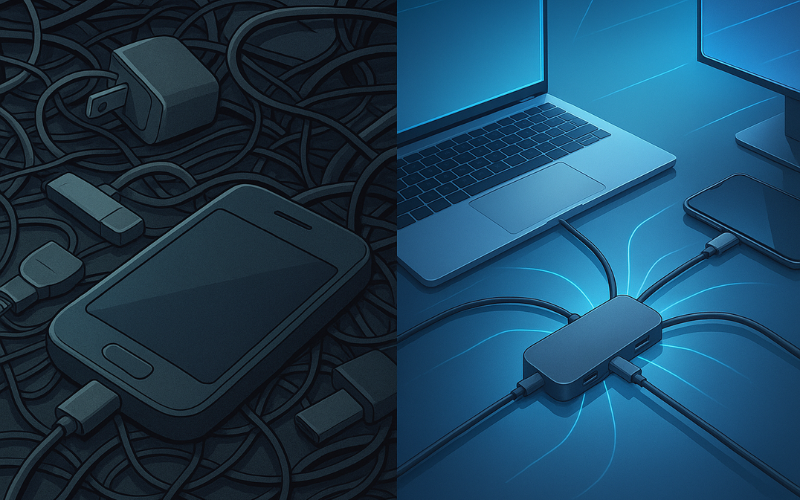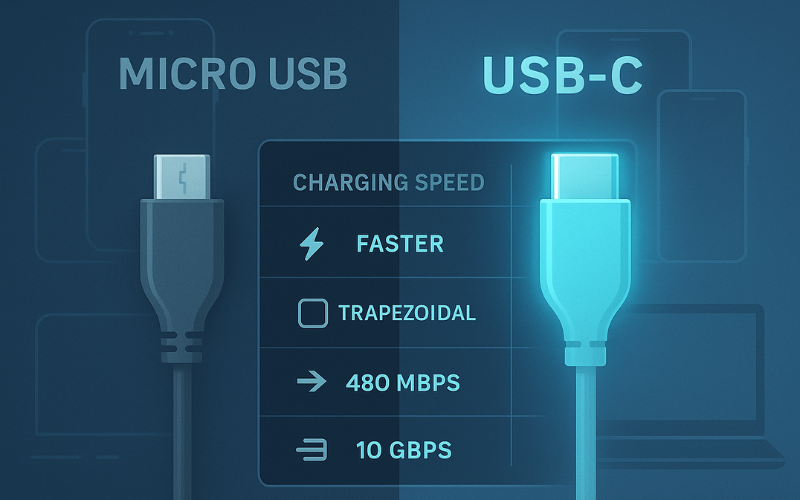USB-C vs Micro USB: Key Differences Explained
In today’s fast-paced tech world, choosing the right charging and data cable matters more than ever. Two of the most commonly discussed connectors are USB-C and Micro USB. While both are widely used, they’re quite different in design, performance, and compatibility.
If you’ve ever fumbled trying to plug in a Micro USB cable or wondered why USB-C seems to be everywhere lately, you’re not alone. Let’s break down how these two connectors stack up against each other.
What is USB-C?
USB-C, also known as Type-C, is the latest standard of USB connectors. It was introduced by the USB Implementers Forum in 2014 and has quickly become the go-to port for modern electronics.
Unlike earlier USB types, USB-C is reversible, meaning you can plug it in either way. It’s used in a wide range of devices including laptops, smartphones, tablets, power banks, and even gaming consoles.
Key Features of USB-C:
- Reversible design for easy plug-in
- Supports fast charging and data transfer
- Delivers up to 240W power with USB Power Delivery (USB PD)
- Capable of video output via DisplayPort or HDMI Alt Mode
- Universally adopted across Android, Windows, and Apple (new iPads and MacBooks)
What is Micro USB?
Micro USB is an older USB standard, commonly found on older Android phones, Bluetooth speakers, power banks, and other small electronics. It comes in two main variants: Micro-A and Micro-B, with Micro-B being the most common.
Micro USB ports have a distinctive trapezoid shape, and the connector must be plugged in one specific way, which often leads to frustration.
Key Features of Micro USB:
- Thin, compact connector mainly used in older devices
- Supports charging and data transfer
- One-way design (non-reversible)
- Maximum power delivery is usually up to 18W
- Becoming less common in newer devices
Design Differences
The most obvious difference between USB-C and Micro USB is their physical design.
| Feature | USB-C | Micro USB |
| Plug Orientation | Reversible | One-way only |
| Connector Shape | Oval, symmetrical | Trapezoid, asymmetrical |
| Pin Count | 24 pins | 5 pins (Micro-B) |
| Cable Durability | More durable and long-lasting | Prone to wear and loose fit |
USB-C has a universal, rounded design that makes it easier to use and less prone to damage. Micro USB’s smaller pin count also limits its capabilities.
Charging Speed and Power Delivery
If charging speed matters to you, USB-C is the clear winner.
USB-C supports USB Power Delivery (USB PD), allowing devices to charge faster and handle larger power loads. You can even charge laptops using a USB-C cable, thanks to its power range of up to 240W.
On the other hand, Micro USB is limited to lower power ranges, typically around 10–18W, which is sufficient for small gadgets but not suitable for high-performance devices.
USB-C Charging Advantages:
- Fast charging with up to 240W
- Smart power negotiation between device and charger
- Used for both small devices and high-power electronics
Data Transfer Speeds
When it comes to data, USB-C again leads the way.
Micro USB usually supports USB 2.0 speeds, which max out at 480 Mbps. Some advanced versions can go up to USB 3.0 with 5 Gbps, but they’re rare and require specially designed ports.
In contrast, USB-C supports USB 3.1, 3.2, and even USB4, offering data transfer rates up to 40 Gbps.
Here’s a quick comparison:
| Connection Type | Data Speed Range |
| Micro USB 2.0 | Up to 480 Mbps |
| Micro USB 3.0 | Up to 5 Gbps (limited) |
| USB-C (USB 3.2) | Up to 20 Gbps |
| USB-C (USB4) | Up to 40 Gbps |
If you’re transferring large files, syncing a phone, or using external SSDs, USB-C is clearly more efficient.
Device Compatibility
Micro USB is still found in some budget phones, older gadgets, and small accessories like wireless headphones and cameras. But its usage is shrinking fast.
USB-C, on the other hand, has become the universal standard across a wide range of devices and brands, including:
- New Android phones and tablets
- Apple iPads and MacBooks (post-2018)
- Windows laptops and Chromebooks
- Nintendo Switch and Steam Deck
- Modern power banks and chargers
This broad compatibility makes USB-C a future-proof choice.
Versatility and Use Cases
One of the biggest advantages of USB-C is its versatility. It doesn’t just handle charging and data transfer it can also transmit video and audio.
Many monitors, docking stations, and hubs use USB-C for video output, replacing traditional HDMI or DisplayPort cables. You can connect a laptop to an external display, charge it, and transfer data all with a single USB-C cable.

Micro USB lacks these advanced functions. It is limited to basic charging and file transfer tasks.
Durability and Build Quality
USB-C connectors are built to be more rugged. Their symmetrical shape ensures minimal wear during repeated plug-ins and removals. This contributes to longer lifespan and better performance over time.
Micro USB ports are more fragile, and frequent usage can lead to:
- Loose connectors
- Bent or broken pins
- Failed charging or data sync
For heavy everyday use, USB-C offers significantly better durability.
Backward Compatibility
One concern for users switching to USB-C is backward compatibility. Fortunately, USB-C supports adapters and converters, allowing users to connect to older USB-A and Micro USB ports.
You can buy a USB-C to Micro USB adapter to charge older devices, though some advanced features like fast charging or video output may not work through adapters.
Micro USB, however, lacks compatibility with newer USB-C devices unless you use dedicated OTG or host cables, and even then functionality is limited.
USB-C Is the Future
With major brands and even governments pushing for universal USB-C standards (like the EU mandate for USB-C chargers), the future is clearly moving away from Micro USB.
Apple has shifted iPads and MacBooks to USB-C, and newer iPhones are following suit. Android manufacturers have already transitioned, and laptops have adopted USB-C as their main or even only port.
Here’s why the shift is happening:
- Faster charging
- Higher data transfer
- Universal compatibility
- Simplified cable management

Micro USB is slowly fading into legacy tech, reserved only for niche or older devices.
Should You Switch to USB-C?
If your current device still uses Micro USB, you don’t need to panic. But for future upgrades, it’s wise to choose devices that support USB-C. The benefits are too significant to ignore.
Benefits of upgrading to USB-C:
- Improved charging speed and efficiency
- Faster data syncing
- Less cable clutter
- One port for multiple functions (charging, data, video)
Investing in USB-C accessories like cables, adapters, or hubs today prepares you for a more streamlined digital future.
Final Thoughts
While Micro USB served us well for over a decade, USB-C is the superior, future-ready connector. With better speed, charging capabilities, and wide adoption across industries, it’s more than just a convenience it’s a necessity.
Whether you’re a tech enthusiast or a casual user, understanding this difference helps you make smarter decisions when buying electronics or accessories.
If you’re upgrading your phone, laptop, or charger go for USB-C. It’s not just faster. It’s smarter, stronger, and here to stay.
Leave a reply